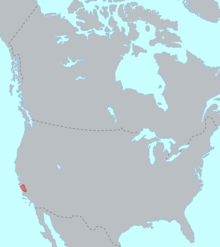Salinan

The Salinans are a Native American tribe whose ancestral territory is south of the Salinas Valley and Santa Lucia Range on the Central Coast of California. Today, the Salinan government is currently working to obtain federal tribal approval from the Bureau of Indian Affairs.

Ebe mmalite[dezie | dezie ebe o si]
There are two major divisions and one minor division. From north to south, Antoniano lived in the bottom of the Salinas Valley (which runs from south to north), near the future location of two missions: (Mission San Antonio de Padua and Mission San Miguel Arcángel). The Miguelinos live along the upper reaches of the Salinas River, and to the south near Slates Hot Springs, Junipero Serra Peak, and Soledad. There was also a small group of Playano on the Pacific coast near what is now Lucia and San Simeon. The Salinans were Hunter-gatherers and, like many other California tribes, organized into small groups with little centralized political structure.
[1]The 56 acres (23 ha) Wagon Caves rock formation about 18 miles (29 km) northwest of present-day Jolon is an archaeological site used by the Salinan Antonianos subtribe [1] [2] who researchers believed to have at least two cities in the area, an ancient site that dates back to around 450 AD and later, a protohistoric site that dates from 1450 to 1650 AD Archaeologists have discovered a stemmed biface, lithic flakes, shell beads, and non-human bones, as well as shell, bone, flaked stone, related firestone, firewood, and weapons. and cave sites. [3] The stone is enclosed in a cave and a cave with a roof of fire that shows that it has been there for many centuries. The 806-acre (326 ha) Wagon Cave Nature Research Area consists of several stands of Valley Oaks of various ages and densities and is designated as a natural research area within the Los Padres National Forest.
Etymology[dezie | dezie ebe o si]
[2]The name of the tribe is derived from the Salinas River, as the Spanish did not understand if the people had a name for themselves. [1] [2] The name of the people is "Te'po'ta'ahl" or "People of the Oaks," according to the current tribal leaders. [3] C. Hart Merriam called these people En-'ne-sen on the advice of a minister; En-'ne-sen is the local word for Salinan headquarters.
Asụsụ[dezie | dezie ebe o si]
[3]The Salinan language, spoken until the 1950s [1] is an isolated language. He may be part of the Hokan family. Sapir included him in the Hokan clan, along with Chumash and Seri; This division has entered into recent encyclopedias in the presentation of language families, but no solid evidence has ever been produced to support it.
Ndị mmadụ[dezie | dezie ebe o si]
[4]Estimates of the number of pre-introduced individuals in many community groups in California have changed significantly. Alfred L. Kroeber put the population of Salinan in 1770 as 3,000. [1] Sherburne F. Cook similarly estimated that there were at least 700 Salinans. [2] The United States Census of 2000 shows the Salinan population as 681.
Hụkwa[dezie | dezie ebe o si]
- Akụkọ ọdịnala Salinan
- Kuksu (okpukpe)
- Nkume esere ese (San Luis Obispo County)
- Chalon
- USS <i id="mwdA">Salinan</i> (ATF-161)
Ihe ndetu[dezie | dezie ebe o si]
- ↑ Wagon Caves. www.fs.fed.us. Retrieved on 31 March 2022.
- ↑ Hester, p.504
- ↑ Marlett 2008
- ↑ Census 2000 PHC-T-18. American Indian and Alaska Native Tribes in the United States: 2000 (September 2002).
Ntụaka[dezie | dezie ebe o si]
- Campbell (1997). American Indian languages: the historical linguistics of Native America. Oxford: Oxford University Press.
- Cook, Sherburne F. 1976. The Conflict between the California Indian and White Civilization. Berkeley, California: University of California Press.
- Kroeber, Alfred L. 1925. Handbook of the Indians of California. Bureau of American Ethnology Bulletin No. 78. Washington, D.C.
- Hester, Thomas R. 1978. Salinan, in Handbook of North American Indians, vol. 8 (California). William C. Sturtevant, and Robert F. Heizer, eds. Washington, DC: Smithsonian Institution, 1978. ISBN 0-16-004578-9 / 0160045754, pages 500–504.
- Marlett, Stephen A. 2008. The Seri-Salinan connection revisited. International Journal of American Linguistics 74.3:393-399.
- Sapir, Edward. 1925. The Hokan affinity of Subtiaba in Nicaragua. American Anthropologist 27: (3).402-34, (4).491-527.
- National Public Radio segment by Allison Herrera, December 13, 2017
